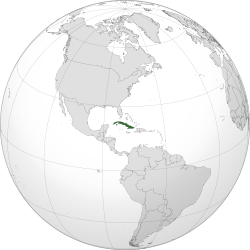Provisional Government of Cuba | |||||||||
|---|---|---|---|---|---|---|---|---|---|
| 1906–1909 | |||||||||
 | |||||||||
| Status | Military occupation by the United States | ||||||||
| Capital | Havana | ||||||||
| Common languages | Spanish, English | ||||||||
| Provisional Governor | |||||||||
• 1906 | William H. Taft | ||||||||
• 1906–1909 | Charles E. Magoon | ||||||||
| Historical era | Modern Era | ||||||||
• U.S. invasion | 28 September 1906 | ||||||||
• Full withdrawal | 6 February 1909 | ||||||||
| |||||||||
| Today part of | Cuba | ||||||||
| Second Occupation of Cuba | |
|---|---|
| Part of the Banana Wars | |
 A 1909 cartoon from Puck showing President Theodore Roosevelt, dressed in his Rough Riders uniform, handing off his policies to the future president, William H. Taft. William Loeb Jr. is at left, holding Roosevelt's "Big Stick." | |
| Type | Military occupation |
| Location | |
| Objective | Protect United States interests, stabilize Cuba, hold free elections |
| Date | 1906–1909 |
| Executed by | United States |
| History of Cuba |
|---|
 |
| Governorate of Cuba (1511–1519) |
|
|
| Viceroyalty of New Spain (1535–1821) |
|
|
| Captaincy General of Cuba (1607–1898) |
|
|
| US Military Government (1898–1902) |
|
|
| Republic of Cuba (1902–1959) |
|
|
| Republic of Cuba (1959–) |
|
|
| Timeline |
|
|
|
|
The Provisional Government of Cuba lasted from September 1906 to February 1909. This period was also referred to as the Second Occupation of Cuba.
When the government of Cuban President Tomás Estrada Palma collapsed, U.S. President Theodore Roosevelt ordered U.S. military forces into Cuba. Their mission was to prevent fighting between the Cubans, to protect U.S. economic interests there, and to hold free elections in order to establish a new and legitimate government. Following the election of José Miguel Gómez in November 1908, U.S. officials judged the situation in Cuba sufficiently stable for the U.S. to withdraw its troops, a process that was completed in February 1909.[1][2]
An earlier occupation lasted from 1898 to 1902, from the conclusion of peace between the United States and Spain at the end of the Spanish–American War until the inauguration of the Republic of Cuba.
- ^ Beede, pg. 28-30
- ^ Article title [bare URL]

